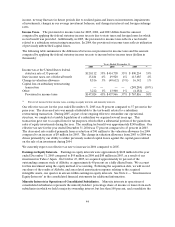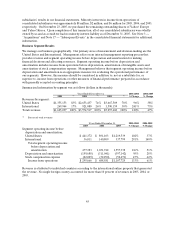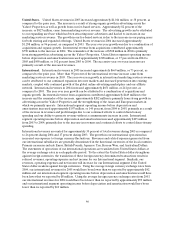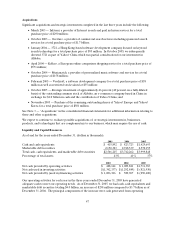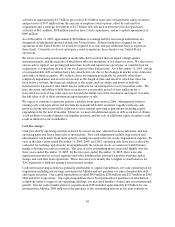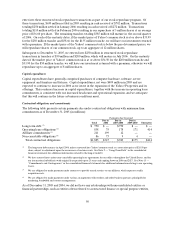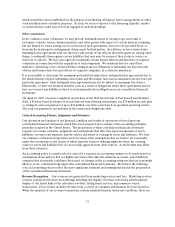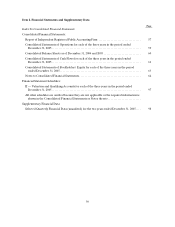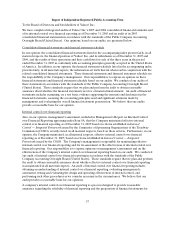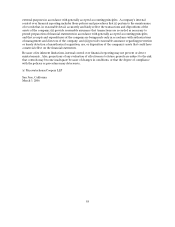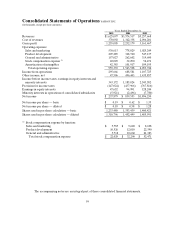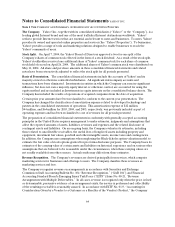Yahoo 2005 Annual Report Download - page 60
Download and view the complete annual report
Please find page 60 of the 2005 Yahoo annual report below. You can navigate through the pages in the report by either clicking on the pages listed below, or by using the keyword search tool below to find specific information within the annual report.54
Item 7A. Quantitative and Qualitative Disclosures about Market Risk
We are exposed to the impact of interest rate changes, foreign currency fluctuations, and changes in the
market values of our investments.
Interest Rate Risk. Our exposure to market rate risk for changes in interest rates relates primarily to our
investment portfolio. We invest excess cash in marketable debt instruments of the United States
Government and its agencies, and in high-quality corporate issuers and, by policy, limit the amount of
credit exposure to any one issuer. We protect and preserve invested funds by limiting default, market and
reinvestment risk.
Investments in both fixed rate and floating rate interest earning instruments carry a degree of interest rate
risk. Fixed rate securities may have their fair market value adversely impacted due to a rise in interest
rates, while floating rate securities may produce less income than expected if interest rates fall. Due in
part to these factors, our future investment income may fall short of expectations due to changes in interest
rates or we may suffer losses in principal if forced to sell securities which have declined in market value
due to changes in interest rates. As of December 31, 2005 and 2004, we had investments in debt securities
with effective maturities between three months and one year of approximately $1.1 billion and $1.9 billion,
respectively. Such investments had a weighted-average yield of approximately 3.5 percent and 2.4 percent,
respectively. As of December 31, 2005 and 2004, we had investments in debt securities with effective
maturities between one and five years of approximately $1.4 billion and $1.0 billion, respectively. Such
investments had a weighted average yield of approximately 3.8 percent and 3.0 percent, respectively. A
hypothetical 100 basis point increase in interest rates would result in an approximate $26 million and
$25 million decrease (approximately 1 percent), respectively, in the fair value of our available-for-sale debt
securities as of December 31, 2005 and 2004.
The fair market value of the zero coupon senior convertible notes (the “Notes”) is subject to interest rate
risk and market risk due to the convertible feature of the Notes. Generally, the fair market value of fixed
interest rate debt will increase as interest rates fall and decrease as interest rates rise. The fair market
value of the Notes will also increase as the market price of the Yahoo! stock increases and decrease as the
market price falls. The interest and market value changes affect the fair market value of the Notes but do
not impact our financial position, cash flows or results of operations. As of December 31, 2005 and 2004,
the fair value of the Notes was approximately $1.4 billion based on quoted market prices.
Foreign Currency Risk. International revenues accounted for approximately 30 percent of total revenues
during 2005 as compared to 26 percent during 2004. The growth in our international operations has
increased our exposure to foreign currency fluctuations. Revenues and related expenses generated from
our international subsidiaries are generally denominated in the functional currencies of the local countries.
Primary currencies include Euros, British Pounds, Japanese Yen, Korean Won and Australian Dollars.
The statements of operations of our international operations are translated into United States dollars at
the average exchange rates in each applicable period. To the extent the United States dollar strengthens
against foreign currencies, the translation of these foreign currency denominated transactions results in
reduced revenues, operating expenses and net income for our International segment. Similarly, our
revenues, operating expenses and net income will increase for our International segment, if the United
States dollar weakens against foreign currencies. Using the average foreign currency exchange rates from
2004, our international revenues for 2005 would have been lower than we reported by approximately
$42 million and our international segment operating income before depreciation and amortization would
have been lower than we reported by $8 million. Using the average foreign currency exchange rates from
2003, our international revenues for 2004 would have been lower than we reported by approximately $59
million and our international segment operating income before depreciation and amortization would have
been lower than we reported by $10 million.


